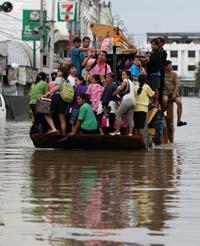Climate change causing havoc in the Philippines

Typhoons, cyclones, floods and droughts in the coming years will impact hundreds of lives, thousands of homes and cost billions of dollars the Philippines, like several other Asian countries, do not have an effective disaster prevention program in place.
As weather patterns become more extreme, many Asian nations must prepare for millions of people to flee their homes to safer havens within countries and across borders the Asian Development Bank warns.
Further, The first comprehensive report by the Global Humanitarian Forum (GHF) into the human cost of climate change also warned that the world is in the throes of a ‘silent crisis’ that kills an estimated 300,000 people each year.
According to the GHF more than 300 million people are already seriously affected by the gradual warming of the Earth and that the number is set to double by 2030.
In the Philippines, floods and landslides marked a traumatic entry into 2011. Affecting more than 1.3 million people and causing approximately $28 million worth of property damage, the calamity of these disasters attests to the devastating consequences of poor urban planning, especially with the emerging hazards of climate change.
Set along the Pacific typhoon belt, the 7,107 islands that comprise the Philippines are persistently besieged by natural disasters. Last year’s 11 tempests caused massive destruction, especially October’s category-five “super” Typhoon Megi assault on Manila and the nearby provinces of Isabela and Cagayan. Within a month, floods submerged these regions before they had a chance to recover, globalmedia.org reported.
Just after the December holiday season, another heavy downpour incited flashfloods and landslides, turning New Year preparations into rescue operations. The National Disaster Risk Reduction and Management Council (NDRRMC) reported a human toll of 53, which included deaths from drowning, electrocution, and from the collapse of a chromite mine tunnel outside of Butuan City.
“This brought to the fore the institutional weaknesses of the country’s urban management systems,” pointed out UN Human Settlements Programme (UN Habitat) spokesperson Sharad Shankardass. “These problems were compounded by climate change, requiring a completely new dimension to urban planning and management.”
The recent calamities are the worst that the Philippines has seen in decades. A tragic 2006 landslide wiped out the village of Guinsaugon in Southern Leyte, killing more than 1,000 people. In September 2009, flashfloods devastated Manila in the aftermath of Typhoon Ondoy, which poured down an alarming 455-millimeter rainfall in 24 hours, surpassing the 250-millimeter record of 2005’s Hurricane Katrina.
The persistent vulnerability of urban areas is due mostly to the lack of useful data for reliable planning, implementing faculty for mandated strategies and programs, and a central institution for urban planning and management, explained Shankardass to MediaGlobal.
Danilo C. Israel of the Philippine Institute for Development Studies (PIDS). said in a paper that from 1990 to 2009, the Philippines suffered $4.813 billion in direct damage, or an average of $240.7 million per year, due to weather and climate-related disasters.
In the decade starting 2000, total losses from damage were placed at $2.121 billion, lower than the total damage of $2.602 billion in the 1990s.
Undersecretary Benito T. Ramos, executive director of the National Disaster Risk Reduction and Management Council of the Philippines, commenting on the dire warnings said Filipinos’ are resilient to such events.
“Here in the Philippines, people are resilient. We have been through all kinds of disasters,” he said, according to media in Manila.
Ramos said with the farm sector to be largely hit by changing weather patterns, the government, through the Agriculture department, has been conducting seminars among farmers on how planting methods should adapt to weather shifts.
“They won’t plant in El Niño but they will diversify their crops in La Niña,” he said.
Meanwhile, economist Agustin L. Arcenas of the University of the Philippines said it is possible for people like farmers to adapt to climate change, but learning new technology will not be immediate.
The problem, he added, is a legitimate concern since assimilation to new societies is not easy, with the government expected to provide support mechanisms in such conditions.
“How large of an issue that can be depends on how the government plans for that,” he said.






